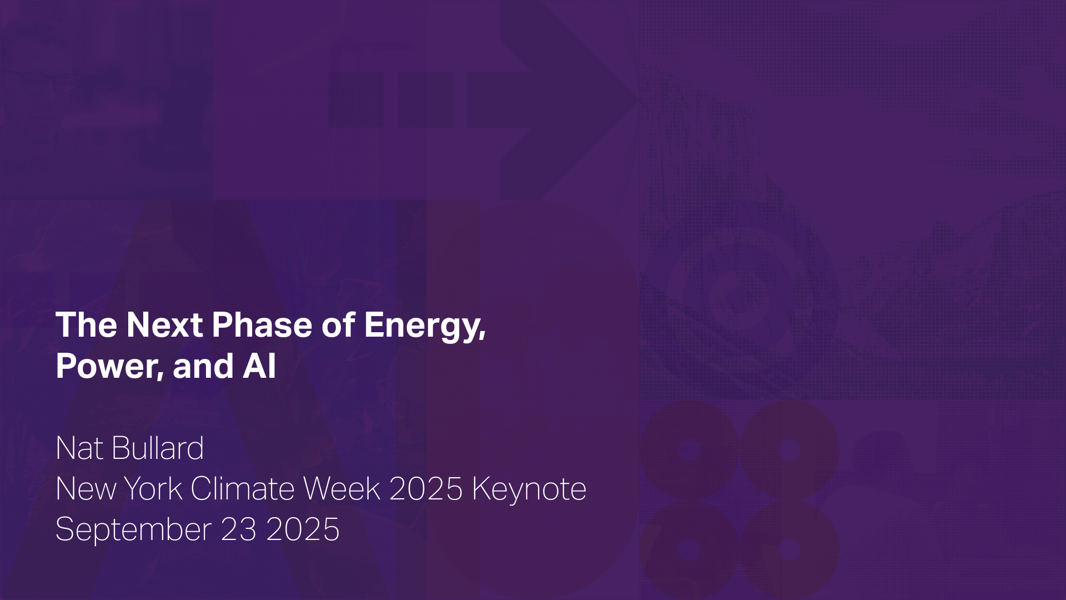I was in New York last week for the event still known as Climate Week, which could today be more accurately described as “energy + finance + AI + data centers + trade + security week.” This expanded rhetorical scope that brings with it both more events (more than 1,000, in fact!) and more talk. Anyone reading this weekly note from Halcyon has probably been deluged with testimonials, LinkedIn posts, thoughtful reflections, and earnest appeals. I’ll spare you those.
Last week at DERVOS in New York, Halcyon ran “wargames” with a room full of industry leaders: major (hypothetical) events, rapid-response scenarios, decisions made in minutes. Halcyon’s software did what it’s built to do: quickly find signal fragmented across millions of regulatory filings, and make it easy to analyze. The exercise also surfaced an old truth: the volume and velocity of energy information are compounding, and analysts working to stay afloat amid this shift need to see what changed as much as what is.
The interface matters
A brief Halcyon history lesson: early on, we leaned into a natural-language interface (popularized by a chatbot you might have heard of ;)) — ask a question, get a sourced answer. Useful, but we quickly learned, insufficient. Most analysts don’t need prose, no matter how well cited; they need a strict type checked int, float, or a string of text, something they can take to a grid-like spreadsheet or model.
So we pre-packaged two recurring themes — gas power plant development and large-load tariffs — into structured data products. Data Products made the answer portable, and provided a much more workflow-friendly solution than a wall of text.
From products to subscriptions
While Data Products were a step forward, they were still imperfect: static files age quickly. The day a spreadsheet ships, something in it is already out of date. For an analyst living in rows and columns, the essential question is temporal: what changed since the last version?
(Paradoxically, the more and more-recent data you have, the harder this is to answer, unless, of course, you have a custom script that computes a binary mask — one that bleeds red when a cell changes from a previous version. But that comes with its own complications: what happens when the dataset itself evolves? When a new column appears, or the schema shifts? Halcyon’s Gas Power Plant Tracker, for instance, has already expanded both horizontally and vertically multiple times since launch in July.)
Enter the changelog.

In our world where information acquisition and analysis is a round-the-clock job, recency is a real competitive advantage. And thanks to the software we’ve built, Halcyon is well positioned to deliver that competitive advantage via frequent updates — more often than the quarterly or semiannual cadence typical of market intelligence. At a monthly frequency, these aren’t Data Products. They’re Data Subscriptions.
Today, we’ve integrated those subscriptions directly into Halcyon’s platform. Current Data Subscriber customers can now access a new dashboard with:
- One-click downloads of the latest files
- Integrated and programmatic changelogs showing what changed, and when, precise to the level of each cell
- Project-level diffs: operational, cancelled, merged/split, etc

Why this matters
- Time collapses. You no longer reconcile versions by hand; the platform shows the delta.
- Decisions improve. Changelogs make provenance visible; analysts can justify a change in view.
- Context compounds. Soon, we’ll more tightly couple the information contained with Data Subscriptions to Halcyon Search and Halcyon Queries, enabling deeper research of linked evidence.
Spreadsheets are a springboard; the destination is a living dashboard — auto-updating, filterable, and tightly linked to Search and Queries. Select a project or a cell and dive straight into associated filings, orders, dockets, and developer disclosures.
Meanwhile, three new Data Subscriptions are currently under construction. Join the waitlist to get notified when they are ready.
- Rate Case / Cost of Capital Tracker: A continuous view of utility rate cases, authorized ROE, capital structures, and precedent—normalized across jurisdictions.
- BESS Tracker: Grid-scale battery projects from interconnection through COD, with chemistries, durations, offtake, and co-location flags.
- New Substation Development Tracker: Planned and in-process substation builds and upgrades — where grid capacity is forming, and for whom.
We’re also currently offering special pricing on an all-access pass that includes subscriptions to these three new trackers in addition to the Gas Power Plant Tracker and Large Load Tariff Tracker. When you join the waitlist, click the box at the bottom that says “I’m interested in learning more about the All-Access pass!” and we will get in touch with you.
Two asks:
- Current subscribers: open the dashboard, skim the changelog, and download the latest.
- Interested in the new trackers? Join the waitlist for promotional pricing that won’t last long!
Subscribe for more content like this; reach out with questions: sayhi@halcyon.io; follow us on LinkedIn and Twitter


.png?width=50&name=34C0AE28-DE08-4066-A0A0-4EE54E5C1C9D_1_201_a%20(1).png)

